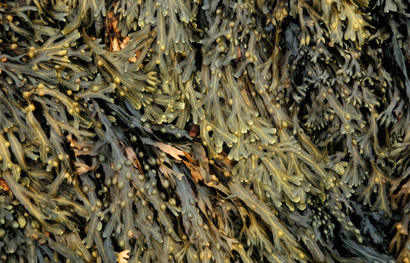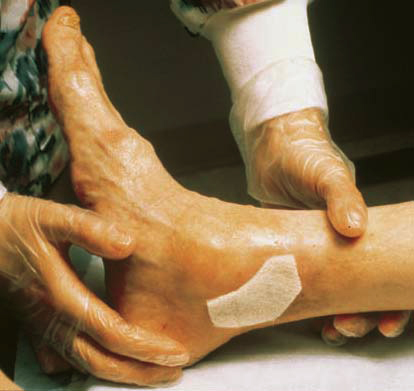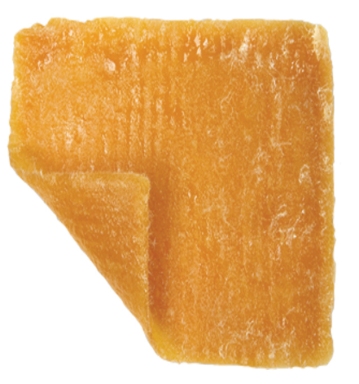What is Alginate?
Alginate is a biopolymer, an alternative plant fibre that is extracted from seaweed. It is a soft fibre that is often blended with other fibres to improve its resilience and although it’s processing produces chemical pollutants, it is biodegradable and nutrient-rich and is said to have antibacterial properties. The use of alginate can be historically traced as far back as 3000 BC within food and medicine.
Unknown, (2011), 3M_Tegaderm_GellingAlginate [ONLINE]. Available at:http://www.allegromedical.com/wound-care-c541/tegagen-hg-alginate-dressing-4-x-4-p191032.html[Accessed 26 November 14].
The process of Calcium alginate
When a soluble calcium salt, such as calcium chloride, is added to the filtered extract, solid calcium alginate is formed.
If the calcium solution and filtered extract are mixed carefully, the calcium alginate can be formed as fibres – bad mixing gives a gelatinous solid.
This fibrous material can be readily separated on a metal screen (sieve) and washed with water to remove excess calcium. It is then stirred in dilute acid and converted to alginic acid, which retains the fibrous characteristics of the calcium alginate.
McHugh, (1987), Flow chart for the production of sodium alginate [ONLINE]. Available at:http://www.fao.org/docrep/006/y4765e/y4765e08.htm#TopOfPage [Accessed 26 November 14].
Speakman A 1895, The precipitation process of sodium alginate/water solutions. Woodhead Publishing, England.
Moisture properties of alginic acid-based fibres
- Common Alginate is a dry solid even though it contains 30% water.
- Insoluble alginate fibres when precipitated from solutions can retain large quantities of water, even when subjected to pressure.
- When dried the insoluble alginate fibres will swell on absorption of water.
Thermal properties of alginic acid based fibres
- Sodium alginate with a degree of polymerization of 500 can be stored, without observable change, for three years of temperatures between 10c and 20c. But temperatures above 50c, degradation will occur. The presence of moisture increases at the rate of degradation.
How is it sustainable?
Alginate is sustainable due to its degradation. The degradation of alginate is due to a variety of factors, which include light, water, atmospheric composition, fungi and microorganisms. Moisture plays an important part of degradation due to microorganisms and bacteria.
Nonwoven alginate fabrics have attracted attention as disposable textiles. Shorter production cycles, high flexibility and versatility and low production cost are some of the claimed advantages.
Why would Alginate work well as a medical textile?
When considering Alginate as a medical fibre it is non-toxic, non-carcinogenic, biocompatible, sterilizable and offers cheap processing by nonwoven technologies. In general, it can be thought that the short-term degradation of textile materials is an undesirable property; however, this very property is useful for alginate products in disposable wound dressings.
Unknown, (2011), 3M_Tegaderm_GellingAlginate [ONLINE]. Available at:http://www.allegromedical.com/wound-care-c541/tegagen-hg-alginate-dressing-4-x-4-p191032.html[Accessed 26 November 14].
What are the alginate-dressing properties?
- They have high absorbency – a high retention capacity
- Good integrity ensures that the fabric has sufficient strength when being handled.
- Flexible to provide comfort ability
- Permeable to gases to allow sufficient oxygenation of tissues – promotes natural healing.
- Good quality stable fibres have been produced from mixed salts of sodium and calcium alginate, and processed into non-woven fabric that is used in wound dressings.
- They have very good wound healing and haemostatic properties and can be absorbed by body fluids because the calcium in the fibre is exchanged for sodium from the body fluid to give a soluble sodium alginate.
- It is then easier to remove these dressings from large open wounds or burns since they do not adhere to the wound.
Modifications of alginate
Muri and Brown (2005: 105) suggest, “Much attention has been focused on absorption, retention properties, non-immunogenic, bioerodible implantation composition and incorporation of medicants to assist the natural haemostatic property of the fibre”
Muri and Brown (2005: 104) also state that “Gilding has patented a porous fibrous material alginate which comprises of cation which is an enzyme co-factor, the cation provides exchangeable ions which have wound healing properties and increased absorbency”
Consumers
Some multinational pharmaceutical companies have launched lines of adhesive bandages and gauze pads based on calcium alginate fibres. They are being promoted as helping blood to clot faster twice as fast.
Pharmaceutical Companies:
- Kaltostat dressings
- Sorbsan Surgical Dressings
- Urgosorb dressing
- Medihoney ApiNate Dressing
Unknown, (2008), Alginate Dressing -limpeza-do-alginate [ONLINE]. Available at:http://galleryhip.com/alginate-dressing.html [Accessed 26 November 14].
MEDIHONEY®, (2005), Medihoney Calcium Alginate Dressing [ONLINE]. Available at:https://www.directmedicalinc.com/catalog/product/1514/derma-sciences-medihoney-calcium-alginate-dressing-31045/ [Accessed 26 November 14].
How often are they used?
Pharmaceutical and medical uses are about 20 percent by value of the market and have stayed buoyant, with 2-4 percent annual growth rates, driven by ongoing developments in controlled release technologies and the use of alginates in wound care applications.
Bibliography
Books
Muri, J & Brown, P (2005). Biodegradable and sustainable fibres . England: Woodhead Publishing. 104-105.
Images
McHugh, (1987), Flow chart for the production of sodium alginate [ONLINE]. Available at:http://www.fao.org/docrep/006/y4765e/y4765e08.htm#TopOfPage [Accessed 26 November 14].
Speakman A 1895, The precipitation process of sodium alginate/water solutions. Woodhead Publishing, England.
Kovalenko, (2011), Alginates which help stabilise silicon anodes can be cheaply obtained from seaweed[ONLINE]. Available at: http://www.rsc.org/chemistryworld/News/2011/September/08091104.asp[Accessed 26 November 14].
Unknown, (2011), 3M_Tegaderm_GellingAlginate [ONLINE]. Available at:http://www.allegromedical.com/wound-care-c541/tegagen-hg-alginate-dressing-4-x-4-p191032.html[Accessed 26 November 14].
Unknown, (2008), Alginate Dressing -limpeza-do-alginate [ONLINE]. Available at:http://galleryhip.com/alginate-dressing.html [Accessed 26 November 14].
MEDIHONEY®, (2005), Medihoney Calcium Alginate Dressing [ONLINE]. Available at:https://www.directmedicalinc.com/catalog/product/1514/derma-sciences-medihoney-calcium-alginate-dressing-31045/ [Accessed 26 November 14].






